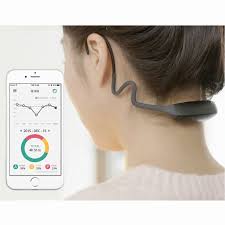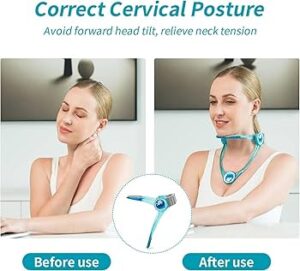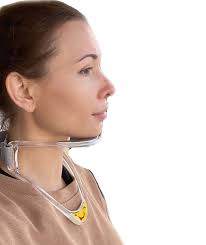

In today’s digital age, many people spend hours hunched over computers, smartphones, or tablets.
This modern-day habit has given rise to a condition commonly referred to as nerd neck, where the head leans forward and the neck slumps.
This posture not only causes discomfort but can also lead to long-term health issues, such as neck pain, stiffness, and even breathing difficulties.
With technology offering solutions to many of our problems, one question arises: Can a posture tracker really fix your nerd neck?
In this article, BestForwardHeadPostureFix shall explore the science behind posture trackers, how they work, and whether they can help correct nerd neck.
I will also look at how long it takes to fix nerd neck, how posture trackers fit into the process, and whether they can prevent nerd neck in the future.
“Can a Posture Tracker Really Fix Your Nerd Neck” Article Index:
- What is Nerd Neck and Why Is It a Problem?
- How to Fix Nerd Neck Posture: Traditional Approaches
- How Posture Trackers Work
- Can a Posture Tracker Fix Nerd Neck?
- Lumo Fitness Tracker and Wearable Posture Trackers: Do They Help?
- How Long Does It Take to Fix Nerd Neck?
- How to Prevent Nerd Neck: Beyond the Posture Tracker
- FAQs on Posture Tracker for Fixing Nerd Neck
- Conclusion: Is a Posture Tracker the Ultimate Nerd Neck Fix?
What is Nerd Neck and Why Is It a Problem?
Nerd neck, technically referred to as forward head posture, occurs when your head juts forward from its natural alignment with your spine.
This misalignment puts excessive pressure on the neck and upper back, leading to strain, discomfort, and even chronic pain.
Over time, this forward posture can weaken the muscles that support the neck, compounding the problem. Nerd neck can also impact your breathing, as the misalignment affects the position of the ribcage and diaphragm.
A 2021 study published in the Journal of Physical Therapy Science found that forward head posture, or nerd neck, is becoming increasingly common due to prolonged use of digital devices.
Left untreated, nerd neck can lead to more severe issues, including herniated discs, muscle imbalances, and tension headaches.
How to Fix Nerd Neck Posture: Traditional Approaches
Before the advent of technology like posture trackers, fixing nerd neck primarily involved exercises and stretches that target the neck and upper back.
Posture tracker checks spinal alignment during desk work and this in turn assist you in leading a normal and healthy life.
Physical therapy often focuses on strengthening the deep neck flexors and the muscles around the shoulder blades. Some of the most common exercises include chin tucks, neck stretches, and upper back strengthening.
While these traditional methods are effective, they require consistency and a lot of mindfulness about posture throughout the day.
This is where posture trackers come into play, as they provide real-time feedback to help correct your posture and make fixing nerd neck easier to manage.
How Posture Trackers Work?
Posture trackers are wearable devices that monitor your posture throughout the day. They use sensors to detect when your body is misaligned, especially in the neck and upper back area.
Most posture trackers work by sending gentle reminders, such as vibrations or notifications, whenever you begin to slouch or move into a forward head position.
These trackers can be worn on the back, shoulders, or even integrated into fitness devices like the Lumo fitness tracker, which provides posture feedback alongside other health metrics.
By consistently using a posture tracker, you can retrain your muscles to maintain proper alignment, reducing the strain that leads to nerd neck.
Can a Posture Tracker Fix Nerd Neck?
The key question is whether a posture tracker can actually fix nerd neck. The answer lies in how posture trackers work in combination with other corrective measures. A posture tracker is not a standalone solution.
While it can help you stay mindful of your posture throughout the day, it works best when combined with exercises that strengthen the neck muscles needed to maintain proper alignment.
A 2020 study published in Applied Ergonomics found that using posture trackers in conjunction with physical therapy led to a more significant improvement in posture than therapy alone.
This indicates that posture trackers can indeed play a crucial role in correcting nerd neck, but they should be seen as a tool rather than a cure.
Lumo Fitness Tracker and Wearable Posture Trackers: Do They Help?
The Lumo fitness tracker is one of the more popular posture-tracking devices on the market. In addition to tracking fitness metrics like steps and calories burned, it also provides feedback on your posture throughout the day.
Many users find it beneficial for staying conscious of their posture, especially during long periods of sitting.
Other wearable posture trackers like Upright and ALEX also aim to fix forward head posture by giving real-time alerts when you begin to slouch.
These trackers are simple to use and often unobtrusive, making them easy to incorporate into your daily routine.
However, while these devices can help you develop better habits, they are not magic solutions.
For long-lasting results, posture trackers must be used in conjunction with a regular exercise regimen that targets the muscles weakened by forward head posture.
How Long Does It Take to Fix Nerd Neck?
One of the most common questions people ask is, how long does it take to fix nerd neck?
The answer depends on several factors, including the severity of your posture problem, how long you have had it, and your commitment to correcting it. On average, it can take anywhere from a few weeks to several months to see significant improvements.
A posture tracker can help speed up the process by providing constant reminders to maintain proper alignment.
According to a 2019 study in Musculoskeletal Disorders Journal, participants who used posture trackers in combination with exercises corrected their nerd neck in about eight weeks, compared to the 12-week period it took for those who relied solely on exercises.
That said, long-term maintenance is crucial. Even after fixing your nerd neck, you will need to continue being mindful of your posture to prevent it from returning.
How to Prevent Nerd Neck: Beyond the Posture Tracker
Once you’ve corrected your forward head posture, it is essential to take steps to prevent nerd neck from coming back. While a posture tracker can help remind you to maintain good posture, you’ll need to make other lifestyle changes to ensure long-term success.
Some tips for how to prevent nerd neck include:
- Ergonomic adjustments: Ensure your workspace is set up in a way that promotes good posture. Keep your screen at eye level and your back supported.
- Regular breaks: Take breaks from screen time every 30-40 minutes. Stand up, stretch, and move around to prevent prolonged slouching.
- Strengthening exercises: Continue doing exercises that strengthen your neck, shoulders, and upper back muscles, such as chin tucks and scapular retractions.
Prevention is just as important as correction. Using a neck posture support like a posture tracker, coupled with lifestyle changes, can help you maintain proper alignment and avoid the return of nerd neck.
Is a Posture Tracker the Ultimate Nerd Neck Fix?
So, can nerd neck be fixed with a posture tracker alone?
While a posture tracker can be an incredibly helpful tool in your journey to fix forward head posture, it is not the ultimate solution on its own.
FAQs on Posture Tracker for Fixing Computer Neck
Q1: How does forward head posture (FHP) impact overall health?
A1: Forward head posture (FHP) can lead to various health issues, including neck pain, headaches, and reduced mobility. It may also affect balance and increase the risk of musculoskeletal disorders.
Q2: What are posture trackers, and how do they function?
A2: Posture trackers are devices designed to monitor and provide feedback on an individual’s posture. They typically use sensors to detect misalignments and alert users to correct their posture, aiming to promote better alignment and reduce discomfort.
Q3: Can posture trackers effectively correct forward head posture?
A3: While posture trackers can raise awareness of FHP and encourage corrective actions, their effectiveness in fully correcting the posture may vary. They are most beneficial when used as part of a comprehensive approach that includes exercises and ergonomic adjustments.
Q4: Are there any studies supporting the use of posture trackers for FHP correction?
A4: Research indicates that posture correction interventions can improve neck posture and reduce associated pain. However, specific studies on posture trackers’ effectiveness for FHP correction are limited.
Q5: How should posture trackers be integrated into a routine to address FHP?
A5: To effectively address FHP, posture trackers should be used alongside corrective exercises, ergonomic adjustments, and regular breaks. This holistic approach can enhance the benefits of posture monitoring devices.
Q6: Are posture trackers suitable for everyone with forward head posture?
A6: Posture trackers can be beneficial for many individuals with FHP, but their suitability depends on individual circumstances. It’s advisable to consult with a healthcare professional to determine the most appropriate intervention for your specific needs.
Conclusion
The tracker helps by reminding you to maintain proper posture throughout the day, which is a crucial component of fixing nerd neck. However, it must be paired with regular exercises, ergonomic adjustments, and a commitment to overall posture improvement.
Ultimately, how to fix nerd neck posture involves a multi-pronged approach.
A posture tracker can speed up the process and keep you on track, but long-term results will depend on your dedication to strengthening and correcting your body’s alignment.
For those struggling with nerd neck, using a wearable posture tracker like the Lumo fitness tracker can certainly help, but remember that there’s no quick fix.
By incorporating the tracker into a well-rounded routine, you’re well on your way to solving your posture problems for good.
References:


